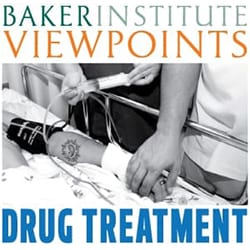Drug policy has experienced an interesting shift recently. Along with legalization of medical and recreational marijuana, many states are also reducing penalties for nonviolent drug offenses and placing greater focus on treatment for drug users. The emphasis on treatment and rehabilitation for drug users is the result of many factors, including recognition that the drug war has not reduced drug use, a desire to reduce the prison population and save money, and a surge in the rate of overdoses from opioid and heroin use. What remains to be seen is whether the current popularity of drug treatment will become a more permanent feature of drug policy. In this Baker Institute Viewpoints series, which runs through Friday, five experts on drug policy examine the question, “Is the current emphasis on treatment in drug policy a short-term trend or is it here to stay?”
The first three priorities outlined in the strategy recently established by President Barack Obama’s Office of National Drug Control Policy (ONDCP) — prevention, treatment and criminal justice system reforms — may seem like a progressive breakthrough in our nation’s lengthy drug war. In fact, since President Richard Nixon first appointed a cabinet-level advisor for drug issues in 1971, each of these three strategies has factored into presidential drug policy with varying degrees of emphasis and alternating tactics for accomplishing each one.
In contrast, the fourth strategy set by today’s ONDCP is unprecedented. The current administration aims to lift the century-old “stigma associated with those in recovery or suffering from substance use disorders.” This strategy hopes to channel the optimism of the recovery movement to bring about a radical cultural shift in society’s attitude toward people with substance use disorders. It is also vital to the long-term success of prevention, treatment and rehabilitative justice projects.
The stigma surrounding many forms of substance use is deeply rooted in American culture. The pejorative term “junkie” hails from 1920s New York, where the heroin users who supported their habit by selling cast-off scrap metal became synonymous with their disposable wares. With trash in hand and a body marked with needles, the illicit heroin user became an almost-classical embodiment of stigma; when the Greeks coined the word “stigma,” it referred to physical marks on the body that branded the wearer a moral inferior. More recently, sociologists have defined stigma as a form of “spoiled identity,” in which an individual’s character is discredited through the revelation of previous addictive behaviors or other socially undesirable experiences.
The rhetorical spoils of opiate addiction extend to people who misuse other psychoactive substances. The anonymity requirement of many 12-step groups is one tactic for managing the stigma of alcoholism and other addictions. A more activist approach to recovery seeks to change the unforgiving social stereotypes that sanction stigmatization in the first place.
Although critics have long argued that stigmatization positively discourages socially harmful behavior, a growing body of research suggests that the stigmatization of people with substance use disorders also has a downside. It has serious health effects, including chronic stress and increased risk of infectious disease transmission. Stigmatization makes people more likely to engage in unsafe drug injection practices and less likely to enter addiction treatment.
Still, most Americans do not view the behavior of people who use substances as a purely medical problem. A 2013 survey of public attitudes about people with drug addiction found respondents were significantly more likely to endorse discriminatory policies (such as unequal access to employment and housing), social exclusion and limited support (for government spending on treatment, housing and other services) for people with drug addiction than for people with other mental illnesses. A significant majority of respondents (60 percent) believed treatment for addiction to be ineffective, compared to a minority (40 percent) who held that view for mental illness. The stigma associated with a sick population can also “spoil” the perception of the treatment system that serves them.
Surprisingly, many health care professionals are no more enlightened about the efficacy of addiction treatment than the general public. Despite recent advances in medical training — such as the integration of motivational interviewing techniques into undergraduate medical education and the expansion of residency programs in addiction medicine — most health care professionals have limited training in treating people with addictive disorders. In general, health care professionals have lower regard for working with this population than with individuals suffering from other chronic conditions such as diabetes or depression.
The root cause of stigma is a lack of education, not an absence of evidence. According to the National Institute on Drug Abuse, relapse rates for people who undergo addiction treatment are comparable to the rates for less-stigmatized chronic illnesses, such as diabetes and hypertension. Since the 1970s, a wealth of clinical literature on addiction treatment outcomes has emerged. There are more than 400 published randomized clinical trials (a study design considered the “gold standard” in medical research) on alcohol use disorder treatment alone.
To combat the skepticism of health care providers and the general public, people struggling with substance use disorders have long relied on the power of personal stories. The 12 steps of Alcoholics Anonymous, a staple of many treatment programs, are often supported by testimonials that blend medical recovery with spiritual reformation. The Substance Abuse and Mental Health Services Administration, the nation’s clearinghouse for treatment data and effectiveness research, has promoted sharing positive recovery stories through community-based events and social media tools.
Greg Williams, director of the documentary “The Anonymous People,” became a public spokesperson after a training session sponsored by the advocacy group Faces and Voices of Recovery. “Today at the level of press, I identify like this: My name is Greg Williams, and I am a person in long-term recovery, and that means I haven’t used alcohol or drugs since I was 17. The goal is to reframe our message for our communities, for our elected officials and for the media. I walked out of that training and for the first time in my life, I felt good about telling someone on a train or telling a reporter my story. I had been given a language of empowerment,” said Williams in a recent interview.
There is some scientific basis for this consciousness-raising strategy: Studies show that increased exposure to people in treatment and recovery helps reduce prejudicial attitudes.
Without a reversal of social and medical attitudes toward substance use disorders, public support for rehabilitation is likely to be short-lived. As a student of medical ethics, however, I have concerns about any health promotion strategy that actively encourages individuals to publicly disclose medical information that may adversely affect their employment opportunities and personal relationships.
For too long, society has placed the burden of proof on this vulnerable population — to demonstrate that they are truly ill, can actually recover and deserve to be reintegrated into mainstream society. Now that the evidence is in, it is time for society to meet the stigmatized halfway.
 Claire D. Clark, Ph.D., M.P.H., is a postdoctoral fellow at the John P. McGovern Center for Humanities and Ethics at the University of Texas Health Science Center at Houston. She is a dual trained historian and behavioral scientist and is working on a book on the rise of the addiction treatment industry since the 1960s. Clark received her Ph.D. and M.P.H. from Emory University.
Claire D. Clark, Ph.D., M.P.H., is a postdoctoral fellow at the John P. McGovern Center for Humanities and Ethics at the University of Texas Health Science Center at Houston. She is a dual trained historian and behavioral scientist and is working on a book on the rise of the addiction treatment industry since the 1960s. Clark received her Ph.D. and M.P.H. from Emory University.
